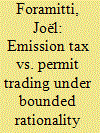| Srl | Item |
| 1 |
ID:
176116


|
|
|
|
|
| Summary/Abstract |
A price on emissions can be achieved through an emission tax or permit trading. The advantages and drawbacks of either instrument are debated. We present an agent-based model to compare their performance under bounded rationality and dynamic markets. It describes firms that face uncertainty about future demand and prices; use heuristic rules to decide production levels, trading prices, and technology adoption; and are heterogeneous in terms of production factors, abatement costs, and trading behavior. Using multiple evaluation criteria and a wide range of parameter values, we find that the main difference between the two policies lies in the fact that permit prices fall after successful abatement. This can lead to higher production levels under permit trading, but can also drive emission-efficient firms out of the market. Scarcity rents under permit trading can further create higher profit rates for firms, the extent of which is shown to depend on the mechanisms for market-clearing and initial allocation.
|
|
|
|
|
|
|
|
|
|
|
|
|
|
|
|
| 2 |
ID:
136187


|
|
|
|
|
| Summary/Abstract |
To control rising energy use and CO2 emissions, China׳s leadership has enacted energy and CO2 intensity targets as part of the Twelfth Five-Year Plan (the Twelfth FYP, 2011–2015). Both to support achievement of these targets and to lay the foundation for a future national market-based climate policy, at the end of 2011, China׳s government selected seven areas to establish pilot emissions trading systems (ETS). In this paper, we provide a comprehensive overview of current status of China׳s seven ETS pilots. Pilots differ in the extent of sectoral coverage, the size threshold for qualifying installations, and other design features that reflect diverse settings and priorities. By comparing the development of the ETS pilots, we identify issues that have emerged in the design process, and outline important next steps for the development of a national ETS.
|
|
|
|
|
|
|
|
|
|
|
|
|
|
|
|
| 3 |
ID:
140485


|
|
|
|
|
| Summary/Abstract |
Chinese development assistance, raw material exploitation, investment and trade increases in their region are causing Pacific Islanders to ask: ‘Why are the Chinese interested in Pacific Island states?’ and ‘Why has there been an upsurge of the Chinese influence in the Pacific?’. This article seeks to add to the debate on that issue by examining the nature and the evolving purpose of Chinese engagement with the small island states of the Pacific. Only a small proportion of China's outbound investment goes to the Pacific Islands, but it has a considerable effect on the region's economically dependent states. Pacific Island nations have a pressing need for overseas investment and are highly dependent on development assistance. They are, therefore, particularly vulnerable to external players.
|
|
|
|
|
|
|
|
|
|
|
|
|
|
|
|